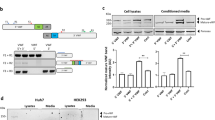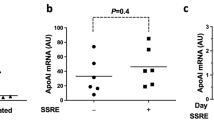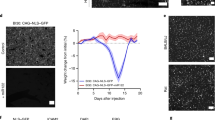Abstract
The success of gene therapy hinges on achievement of adequate transgene expression. To ensure high transgene expression, many gene-therapy vectors include highly active virus-derived transcriptional elements. Other vectors include tissue-specific eukaryotic transcriptional elements, intended to limit transgene expression to specific cell types, avoid toxicity and prevent immune responses. Unfortunately, tissue specificity is often accompanied by lower transgene expression. Here, we use eukaryotic (murine) transcriptional elements and a virus-derived posttranscriptional element to build cassettes designed to express a potentially therapeutic gene (interleukin (IL)-10) in large-vessel endothelial cells (ECs) at levels as high as obtained with the cytomegalovirus (CMV) immediate early promoter, while retaining EC specificity. The cassettes were tested by incorporation into helper-dependent adenoviral vectors, and transduction into bovine aortic EC in vitro and rabbit carotid EC in vivo. The murine endothelin-1 promoter showed EC specificity, but expressed only 3% as much IL-10 mRNA as CMV. Inclusion of precisely four copies of an EC-specific enhancer and a posttranscriptional regulatory element increased IL-10 expression to a level at or above the CMV promoter in vivo, while retaining—and possibly enhancing—EC specificity, as measured in vitro. The cassette reported here will likely be useful for maximizing transgene expression in large-vessel EC, while minimizing systemic effects.
This is a preview of subscription content, access via your institution
Access options
Subscribe to this journal
Receive 12 print issues and online access
$259.00 per year
only $21.58 per issue
Buy this article
- Purchase on Springer Link
- Instant access to full article PDF
Prices may be subject to local taxes which are calculated during checkout







Similar content being viewed by others

References
De Caterina R, Libby P (eds). Endothelial Dysfunctions and Vascular Disease. Blackwell: Malden, MA, 2007: 416 pp.
Yla-Herttuala S, Martin JF . Cardiovascular gene therapy. Lancet 2000; 355: 213–222.
Baker AH . Development and use of gene transfer for treatment of cardiovascular disease. J Card Surg 2002; 17: 543–548.
Gaffney MM, Hynes SO, Barry F, O’Brien T . Cardiovascular gene therapy: current status and therapeutic potential. Br J Pharmacol 2007; 152: 175–188.
Rissanen TT, Yla-Herttuala S . Current status of cardiovascular gene therapy. Mol Ther 2007; 15: 1233–1247.
Wen S, Schneider DB, Driscoll RM, Vassalli G, Sassani AB, Dichek DA . Second-generation adenoviral vectors do not prevent rapid loss of transgene expression and vector DNA from the arterial wall. Arterioscler Thromb Vasc Biol 2000; 20: 1452–1458.
Gruchala M, Bhardwaj S, Pajusola K, Roy H, Rissanen TT, Kokina I et al. Gene transfer into rabbit arteries with adeno-associated virus and adenovirus vectors. J Gene Med 2004; 6: 545–554.
Channon KM, Qian H, Youngblood SA, Olmez E, Shetty GA, Neplioueva V et al. Acute host-mediated endothelial injury after adenoviral gene transfer in normal rabbit arteries: impact on transgene expression and endothelial function. Circ Res 1998; 82: 1253–1262.
Newman KD, Dunn PF, Owens JW, Schulick AH, Virmani R, Sukhova G et al. Adenovirus-mediated gene transfer into normal rabbit arteries results in prolonged vascular cell activation, inflammation, and neointimal hyperplasia. J Clin Invest 1995; 96: 2955–2965.
Modlich U, Pugh CW, Bicknell R . Increasing endothelial cell specific expression by the use of heterologous hypoxic and cytokine-inducible enhancers. Gene Ther 2000; 7: 896–902.
Reynolds PN, Nicklin SA, Kaliberova L, Boatman BG, Grizzle WE, Balyasnikova IV et al. Combined transductional and transcriptional targeting improves the specificity of transgene expression in vivo. Nat Biotechnol 2001; 19: 838–842.
Nicklin SA, Reynolds PN, Brosnan MJ, White SJ, Curiel DT, Dominiczak AF et al. Analysis of cell-specific promoters for viral gene therapy targeted at the vascular endothelium. Hypertension 2001; 38: 65–70.
Velasco B, Ramirez JR, Relloso M, Li C, Kumar S, Lopez-Bote JP et al. Vascular gene transfer driven by endoglin and ICAM-2 endothelial-specific promoters. Gene Therapy 2001; 8: 897–904.
De Palma M, Venneri MA, Naldini L . In vivo targeting of tumor endothelial cells by systemic delivery of lentiviral vectors. Hum Gene Ther 2003; 14: 1193–1206.
Richardson TB, Kaspers J, Porter CD . Retroviral hybrid LTR vector strategy: functional analysis of LTR elements and generation of endothelial cell specificity. Gene Therapy 2004; 11: 775–783.
White SJ, Papadakis ED, Rogers CA, Johnson JL, Biessen EA, Newby AC . In vitro and in vivo analysis of expression cassettes designed for vascular gene transfer. Gene Therapy 2008; 15: 340–346.
Varda-Bloom N, Shaish A, Gonen A, Levanon K, Greenbereger S, Ferber S et al. Tissue-specific gene therapy directed to tumor angiogenesis. Gene Therapy 2001; 8: 819–827.
Greenberger S, Shaish A, Varda-Bloom N, Levanon K, Breitbart E, Goldberg I et al. Transcription-controlled gene therapy against tumor angiogenesis. J Clin Invest 2004; 113: 1017–1024.
Szymanski P, Anwer K, Sullivan SM . Development and characterization of a synthetic promoter for selective expression in proliferating endothelial cells. J Gene Med 2006; 8: 514–523.
Levanon K, Varda-Bloom N, Greenberger S, Barshack I, Goldberg I, Orenstein A et al. Vascular wall maturation and prolonged angiogenic effect by endothelial-specific platelet-derived growth factor expression. Pathobiology 2006; 73: 149–158.
Minami T, Aird WC . Endothelial cell gene regulation. Trends Cardiovasc Med 2005; 15: 174–184.
Papadakis ED, Nicklin SA, Baker AH, White SJ . Promoters and control elements: designing expression cassettes for gene therapy. Curr Gene Ther 2004; 4: 89–113.
Wen S, Graf S, Massey PG, Dichek DA . Improved vascular gene transfer with a helper-dependent adenoviral vector. Circulation 2004; 110: 1484–1491.
Bu X, Quertermous T . Identification of an endothelial cell-specific regulatory region in the murine endothelin-1 gene. J Biol Chem 1997; 272: 32613–32622.
Zufferey R, Donello JE, Trono D, Hope TJ . Woodchuck hepatitis virus posttranscriptional regulatory element enhances expression of transgenes delivered by retroviral vectors. J Virol 1999; 73: 2886–2892.
Terkeltaub RA . IL-10: an ‘immunologic scalpel’ for atherosclerosis? Arterioscler Thromb Vasc Biol 1999; 19: 2823–2825.
De Geest B, Van Linthout S, Lox M, Collen D, Holvoet P . Sustained expression of human apolipoprotein A-I after adenoviral gene transfer in C57BL/6 mice: role of apolipoprotein A-I promoter, apolipoprotein A-I introns, and human apolipoprotein E enhancer. Hum Gene Ther 2000; 11: 101–112.
Schneider DB, Vassalli G, Wen S, Driscoll RM, Sassani AB, DeYoung MB et al. Expression of Fas ligand in arteries of hypercholesterolemic rabbits accelerates atherosclerotic lesion formation. Arterioscler Thromb Vasc Biol 2000; 20: 298–308.
Schambach A, Bohne J, Baum C, Hermann FG, Egerer L, von Laer D et al. Woodchuck hepatitis virus post-transcriptional regulatory element deleted from X protein and promoter sequences enhances retroviral vector titer and expression. Gene Therapy 2006; 13: 641–645.
Schiedner G, Hertel S, Johnston M, Biermann V, Dries V, Kochanek S . Variables affecting in vivo performance of high-capacity adenovirus vectors. J Virol 2002; 76: 1600–1609.
Qin L, Ding Y, Pahud DR, Chang E, Imperiale MJ, Bromberg JS . Promoter attenuation in gene therapy: interferon-gamma and tumor necrosis factor-alpha inhibit transgene expression. Hum Gene Ther 1997; 8: 2019–2029.
Salem HK, Ranjzad P, Driessen A, Appleby CE, Heagerty AM, Kingston PA . Beta-adrenoceptor blockade markedly attenuates transgene expression from cytomegalovirus promoters within the cardiovascular system. Arterioscler Thromb Vasc Biol 2006; 26: 2267–2274.
Ross R . Atherosclerosis—an inflammatory disease. N Engl J Med 1999; 340: 115–126.
Tal R, Shaish A, Rofe K, Feige E, Varda-Bloom N, Afek A et al. Endothelial-targeted gene transfer of hypoxia-inducible factor-1alpha augments ischemic neovascularization following systemic administration. Mol Ther 2008; 16: 1927–1936.
Shaw LC, Pan H, Afzal A, Calzi SL, Spoerri PE, Sullivan SM et al. Proliferating endothelial cell-specific expression of IGF-I receptor ribozyme inhibits retinal neovascularization. Gene Therapy 2006; 13: 752–760.
Miao CH, Ohashi K, Patijn GA, Meuse L, Ye X, Thompson AR et al. Inclusion of the hepatic locus control region, an intron, and untranslated region increases and stabilizes hepatic factor IX gene expression in vivo but not in vitro. Mol Ther 2000; 1: 522–532.
Xu ZL, Mizuguchi H, Ishii-Watabe A, Uchida E, Mayumi T, Hayakawa T . Optimization of transcriptional regulatory elements for constructing plasmid vectors. Gene 2001; 272: 149–156.
Dong G, Schulick AH, DeYoung MB, Dichek DA . Identification of a cis-acting sequence in the human plasminogen activator inhibitor type-1 gene that mediates transforming growth factor-b1 responsiveness in endothelium in vivo. J Biol Chem 1996; 271: 29969–29977.
Raper SE, Chirmule N, Lee FS, Wivel NA, Bagg A, Gao GP et al. Fatal systemic inflammatory response syndrome in a ornithine transcarbamylase deficient patient following adenoviral gene transfer. Mol Genet Metab 2003; 80: 148–158.
Parks RJ, Bramson JL, Wan Y, Addison CL, Graham FL . Effects of stuffer DNA on transgene expression from helper-dependent adenovirus vectors. J Virol 1999; 73: 8027–8034.
Houston P, White BP, Campbell CJ, Braddock M . Delivery and expression of fluid shear stress-inducible promoters to the vessel wall: applications for cardiovascular gene therapy. Hum Gene Ther 1999; 10: 3031–3044.
Perkins HD, van Leeuwen BH, Hardy CM, Kerr PJ . The complete cDNA sequences of IL-2, IL-4, IL-6 and IL-10 from the European rabbit (Oryctolagus cuniculus). Cytokine 2000; 12: 555–565.
Donello JE, Loeb JE, Hope TJ . Woodchuck hepatitis virus contains a tripartite posttranscriptional regulatory element. J Virol 1998; 72: 5085–5092.
Kingsman SM, Mitrophanous K, Olsen JC . Potential oncogene activity of the woodchuck hepatitis post-transcriptional regulatory element (WPRE). Gene Therapy 2005; 12: 3–4.
Mittereder N, March KL, Trapnell BC . Evaluation of the concentration and bioactivity of adenovirus vectors for gene therapy. J Virol 1996; 70: 7498–7509.
Acknowledgements
We thank AdVec, Inc. for permission to use the HDAd reagents, David Russell for providing the WPRE, Axel Schambach for the oPRE sequence, Harvey Perkins for the rabbit IL-10 cDNA, Steve Hauschka for helpful discussions, and Thomas Quertermous for the murine ET-1 sequences. Sofia Penev provided valuable technical help, and we are grateful to Margo Weiss for administrative assistance. This work was supported by National Institutes of Health grant HL076226 and the John L Locke, Jr Charitable Trust. Jordan Kho was supported in part by a grant to the University of Washington from the Howard Hughes Medical Institute through the Undergraduate Science Education Program. This work has been funded by the NIH.
Author information
Authors and Affiliations
Corresponding author
Ethics declarations
Competing interests
The authors declare no conflict of interest.
Additional information
Supplementary Information accompanies the paper on Gene Therapy website
Rights and permissions
About this article
Cite this article
Dronadula, N., Du, L., Flynn, R. et al. Construction of a novel expression cassette for increasing transgene expression in vivo in endothelial cells of large blood vessels. Gene Ther 18, 501–508 (2011). https://doi.org/10.1038/gt.2010.173
Received:
Revised:
Accepted:
Published:
Issue Date:
DOI: https://doi.org/10.1038/gt.2010.173
Keywords
This article is cited by
-
High-throughput 5′ UTR engineering for enhanced protein production in non-viral gene therapies
Nature Communications (2021)
-
Expression of Apolipoprotein A-I in Rabbit Carotid Endothelium Protects Against Atherosclerosis
Molecular Therapy (2011)


